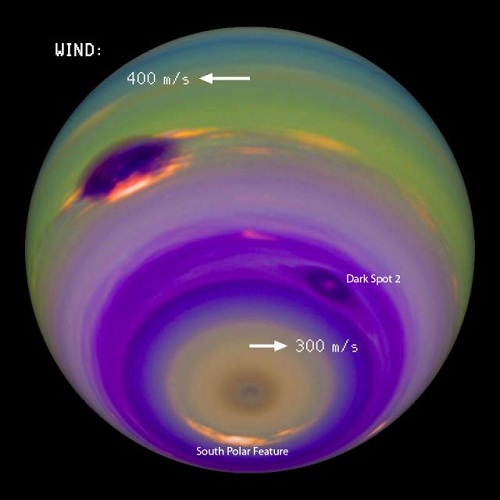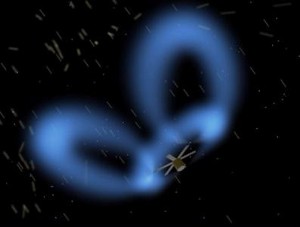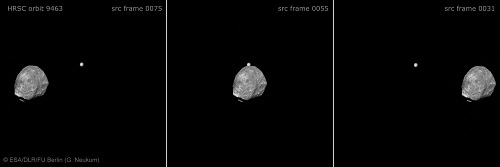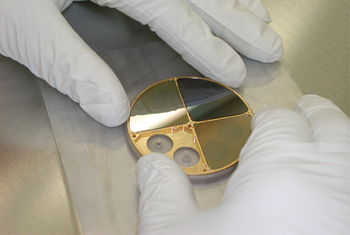Centauri Dreams
Imagining and Planning Interstellar Exploration
Spacetime Beyond the Planck Scale
Is the universe at the deepest level grainy? In other words, if you keep drilling down to smaller and smaller scales, do you reach a point where spacetime is, like the grains of sand on a beach, found in discrete units? It’s an interesting thought in light of recent observations by ESA’s Integral gamma-ray observatory, but before we get to Integral, I want to ponder the spacetime notion a bit further, using Brian Greene’s superb new book The Hidden Reality as my guide. Because how spacetime is put together has obvious implications for our philosophy of science.
Consider how we measure things, and the fact that we have to break phenomena into discrete units to make sense of them. Here’s Greene’s explanation:
For the laws of physics to be computable, or even limit computable, the traditional reliance on real numbers would have to be abandoned. This would apply not just to space and time, usually described using coordinates whose values can range over the real numbers, but also for all other mathematical ingredients the laws use. The strength of an electromagnetic field, for example, could not vary over real numbers, but only over a discrete set of values. Similarly for the probability that the electron is here or there.
By ‘limit computable,’ Greene refers to ‘functions for which there is a finite algorithm that evaluates them to ever greater precision.’ He goes on to invoke the work of computer scientist Jürgen Schmidhuber:
Schmidhuber has emphasized that all calculations that physicists have ever carried out have involved the manipulation of discrete symbols (written on paper, on a blackboard, or input to a computer). And so, even though this body of scientific work has always been viewed as involving the real numbers, in practice it doesn’t. Similarly for all quantities ever measured. No device has infinite accuracy and so our measurements always involve discrete numerical outputs. In that sense, all the successes of physics can be read as successes for a digital paradigm. Perhaps, then, the true laws themselves are, in fact, computable (or limit computable).
If computable mathematical functions are those that can be successfully evaluated by a computer using a finite set of discrete instructions, the question then becomes whether our universe is truly describable at the deepest levels using such functions. Can we reach an answer that is more than an extremely close approximation? If the answer is yes, then we move toward a view of physical reality where the continuum plays no role. But let Greene explain the implications:
Discreteness, the core of the computational paradigm, should prevail. Space surely seems continuous, but we’ve only probed it down to a billionth of a billionth of a meter. It’s possible that with more refined probes we will one day establish that space is fundamentally discrete; for now, the question is open. A similar limited understanding applies to intervals of time. The discoveries [discussed in Greene’s Chapter 9] which yield information capacity of one bit per Planck area in any region of space, constitute a major step in the direction of discreteness. But the issue of how far the digital paradigm can be taken remains far from settled.
And Greene goes on, in this remarkable study of parallel universes as conceived by physics today, to say that his own guess is that we will find the universe is fundamentally discrete.
All of this gets me to the Integral observatory. Because underlying what Greene is talking about is the fact that the General Theory of Relativity describes properties of gravity under the assumption that space is smooth and continuous, not discrete. Quantum theory, on the other hand, suggests that space is grainy at the smallest scales, and it’s the unification, and reconciliation, of these ideas that is wrapped up in the continuing search for a theory of ‘quantum gravity.’
New results from Integral can’t give us a final answer, but they do put limits on the size of the quantum ‘grains’ of space, showing us that they must be smaller than at least some theories of quantum gravity suggest. All of this comes courtesy of a gamma-ray burst — specifically, GRB 041219A, which took place on the 19th of December back in 2004. This was an extremely bright GRB (among the top one percent of GRB detections), and it was bright enough that Integral was able to measure the polarization of its gamma rays. The so-called ‘graininess’ of space should affect how gamma rays travel, changing their polarization (the direction in which they oscillate).
In fact, high-energy gamma rays should show marked differences in polarization from their lower-energy counterparts. Yet studying the difference in polarization between the two types of gamma rays, Philippe Laurent of CEA Saclay and his collaborators found no differences in polarization to the accuracy limits of the data. Theories have suggested that the quantum nature of space should become apparent at the Planck scale: 10-35 of a meter. But the Integral observations are 10,000 times more accurate than any previous measurements and show that if quantum graininess exists, it must occur at a level of at least 10-48 m or smaller.
“Fundamental physics is a less obvious application for the gamma-ray observatory, Integral,” notes Christoph Winkler, ESA’s Integral Project Scientist. “Nevertheless, it has allowed us to take a big step forward in investigating the nature of space itself.”
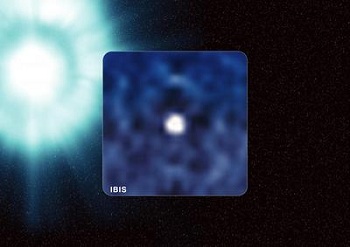
Indeed. Philippe Laurent is already talking about the significance of the result in helping us rule out some versions of string theory and some quantum loop gravity ideas. But many possibilities remain. The new findings that will come from further study will not displace earlier laws so much as extend them into new realms. In this sense past discoveries are rarely irrelevant, and it is a tribute to the coherency of physics that new perspectives so often incorporate earlier thinking. Thus Newton is not displaced by Einstein but becomes part of a more comprehensive synthesis.
Image: Integral’s IBIS instrument captured the gamma-ray burst (GRB) of 19 December 2004 that Philippe Laurent and colleagues have now analysed in detail. It was so bright that Integral could also measure its polarisation, allowing Laurent and colleagues to look for differences in the signal from different energies. The GRB shown here, on 25 November 2002, was the first captured using such a powerful gamma-ray camera as Integral’s. When they occur, GRBs shine as brightly as hundreds of galaxies each containing billions of stars. Credits: ESA/SPI Team/ECF.
Greene points out in The Hidden Reality that Isaac Newton himself never thought the laws he discovered were the only truths we would need. He saw a universe far richer than those his laws implied, and his statement on the fact is always worth quoting:
“I do not know what I may appear to the world, but to myself I seem to have only been a boy playing on the seashore, diverting myself in now and then finding a smoother pebble or prettier shell than ordinary, whilst the great ocean of truth lay before me all undiscovered.”
The impressive Integral results offer us data that may one day help in the unification of quantum theory and gravity. Thus the distant collapse of a massive star into a neutron star or a black hole during a supernova, the apparent cause of most GRBs, feeds new material to theoreticians and spurs the effort to probe even deeper. In the midst of this intellectual ferment, I strongly recommend Greene’s The Hidden Reality as a way to track recent cosmological thinking. I’ve spent weeks over this one, savoring the language, making abundant notes. Don’t miss it.
For more, see Laurent et al., “Constraints on Lorentz Invariance Violation using integral/IBIS observations of GRB041219A,” Physical Review D, Vol. 83, issue 12 (28 June, 2011). Abstract available.

Cosmos & Culture: A Review
By Larry Klaes
Tau Zero journalist Larry Klaes gives us a look at a NASA publication whose authors tackle the biggest questions imaginable for our culture. Usefully, this volume, whose authors include major names in fields ranging from astrophysics to cultural evolution, is available online at no charge. As Larry points out, it deserves wide readership, for the issues of our place in the universe and how we respond to potential extraterrestrial contact via SETI will guide our future, both on Earth and in space.
It is often difficult to get a wider perspective on existence, especially when you and the rest of your species have been stuck in one place for all but the smallest and most recent of times. This has certainly been the case with the species known as humanity. While a few ancient philosophers guessed that we live on a world surrounded by an immense amount of stars and space, it has only been in the last few centuries that both the scientific and general communities came to accept this state of existence as a fact. It has been an even shorter period of time – mere decades – since we have sent our mechanical emissaries and a relative handful of actual humans into the nearest regions of our cosmic neighborhood.
Why are we fascinated with a realm that is unimaginably vast, difficult to attain, and even dangerous? Does that which occurs in space affect life on Earth, and in what ways? Are there other intelligent beings in the Universe and what may result if we should ever encounter one another? What will be the fate of all life far down the cosmic road?
Tackling these mighty subjects is a book titled Cosmos & Culture: Cultural Evolution in a Cosmic Context (NASA SP-2009-4802), edited by Steven J. Dick and Mark L. Lupisella. Most NASA publications deal with the illustrious history of the US space program, often going into great detail about the people, processes, and machines. Cosmos & Culture looks at the ultimate reasons why we want to explore and settle space and how that decision will affect our society and species.
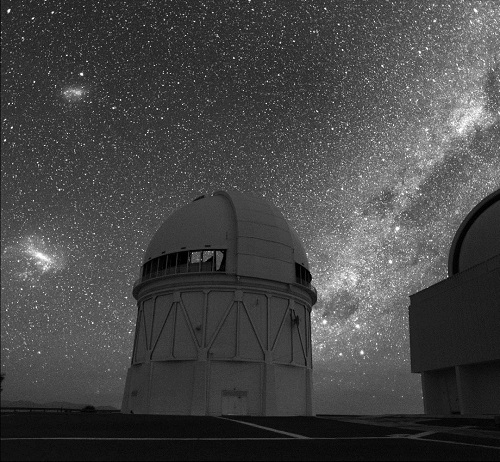
Image: The sky confronts us nightly with the immensity of the cosmos. Here we’re looking at southern skies from the vantage of the Cerro Tololo Inter-American Observatory atop a Chilean mountain. Look carefully and you’ll see both the Small and Large Magellanic Clouds, along with the great band of the Milky Way at right and the Southern Cross just to the right of the 4-meter telecope called Blanco. Credit: Roger Smith, AURA, NOAO, NSF.
This topic is refreshing to see in a work from the space agency: With many space missions, one can sometimes get only vague platitudes as to why we seek to know what is out there. This sometimes creates a sense that the rest of the Universe — and why science goes about studying it — has no real, immediate relation to human society. With Cosmos & Culture, professionals from a variety of fields look at the Universe from their particular perspectives and attempt to bring it all together to show why and how the evolution and development of the Cosmos is anything but esoteric for our own biological and cultural development.
The result is a combination of fascinating ideas that go beyond the usual NASA literature, though sometimes they tend to get rather bogged down in their own explanations. Add to this the fact that many of the ideas presented in this book are admittedly speculation and one tends to worry that the results will be akin to reading a tract on a new form of religion. Nevertheless, the authors are sincere and excited in their efforts here and one knows that even if some of the answers are not what the questioners assumed or hoped for, they do succeed in bringing home the fact that we are an integral part of a much larger world than most of our forbearers could even consider. This is an idea that could literally and ultimately be the difference between either evolution or extinction for humanity.
One of the more important themes in this book is that of extraterrestrial life. The authors on this subject want to know if alien beings exist for three main reasons:
- To see how other creatures have evolved
- To find out if we can communicate with each other
- To understand how our interactions will change us as we expand into the galaxy and beyond.
The authors examine not only what kind of minds could exist besides our own and how they might affect us on various levels, but how our attempts and plans to explain ourselves and our world to alien intelligences shape our perspectives and ultimately our very existence in the process. As Douglas A. Vakoch, the Director of Interstellar Message Composition at The SETI Institute, says in Chapter 12: Encoding Our Origins:
“Although the focus of SETI is on making contact with intelligence beyond Earth, the exercise of portraying ourselves in interstellar messages provides us with an opportunity to cultivate greater intelligence on our own planet.”
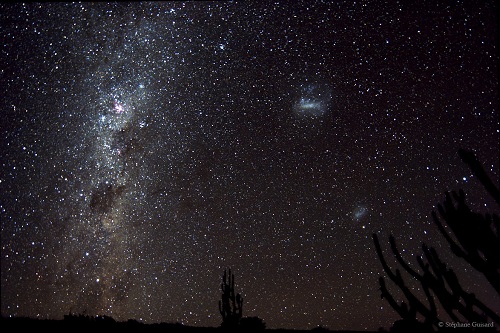
Image: Another look at southern skies, with the Milky Way and the Large and Small Magellanic Clouds framed by cacti from the Atacama desert in this superb photograph by Stéphane Guisard.
Though some chapters are easier to digest than others at a first sitting, Cosmos & Culture makes for a fascinating read. One is guaranteed to learn quite a few new facts and concepts even from a brief swim in these waters thanks to the variety of professionals who have come together to share their ideas. One also realizes how important this book is for our species to grasp the grander picture of reality, for we cannot even afford to pretend to be the focal point of existence any more if we want to avoid societal stagnation or worse. Cosmos & Culture does not claim to have all the answers, but this collection has certainly pointed the way towards some very interesting paths.
Cosmos & Culture: Cultural Evolution in a Cosmic Context is available online.

Neptune: New Discovery from Old Data
If you’re trying to figure out how fast a gas giant rotates, you have your work cut out for you. Jupiter seems to present the easiest case because of the famed Red Spot, first observed by the Italian astronomer Giovanni Cassini. But gas giants are thought to have a relatively small solid core, one that is completely obscured by their atmospheres. Rotation involves atmospheric effects as the gases slosh and swirl. No wonder astronomers were glad to find Jupiter’s pulsating radio beams, discovered in the 1950s. Rotation of the planet’s inner core results in a magnetic field that produces these signals, offering our best estimate on the planet’s actual rate of rotation.
We now know that the largest of the planets is also the fastest rotating, completing one rotation every 9.9 hours. But even this turns out to be an average because the gaseous nature of the planet causes it to experience differential rotation. Head for the poles and you find a slightly slower rotation period than you do at the equator. The rotation speed of the Jovian magnetosphere is usually the rate cited, but Jupiter teaches how tricky gas giants can be. The equatorial bulge caused by its swift rotation even makes it tricky to measure the planet’s diameter, which will vary depending on whether you measure it from the equator or the poles.
The Problem with Neptune
University of Arizona planetary scientist Erich Karkoschka had to keep such issues in mind when he went to work on the rotation rate of Neptune, another planet whose surface is shrouded by a thick atmosphere. The scientist went on to analyze publicly available images of Neptune from the Hubble Space Telescope archive, studying 500 of them to record details of the atmosphere and track distinctive features over long periods of time. Two features in Neptune’s atmosphere drew his attention, rotating five times more steadily even than Saturn’s hexagon, an atmospheric feature previously thought to be the most regularly rotating feature of any of the gas giants.
The two Neptunian features are known as the South Polar Feature and the South Polar Wave, and the odds favor their being vortices in the atmosphere similar to Jupiter’s Red Spot. Using the Hubble imagery, Karkoschka was able to track them over the course of twenty years. He arrived at a rate for Neptune’s rotation that he believes to be 1,000 times better than earlier estimates. The regularity was remarkable: Both features appear exactly every 15.9663 hours, with less than a few seconds of variation. The regularity suggests these features have some kind of connection to Neptune’s interior, possibly the result of convection driven by warmer and cooler atmospheric areas, but at this point, the exact process remains to be determined.
Image: In this image, the colors and contrasts were modified to emphasize the planet’s atmospheric features. The winds in Neptune’s atmosphere can reach the speed of sound or more. Neptune’s Great Dark Spot stands out as the most prominent feature on the left. Several features, including the fainter Dark Spot 2 and the South Polar Feature, are locked to the planet’s rotation, which allowed Karkoschka to precisely determine how long a day lasts on Neptune. (Credit: Erich Karkoschka).
Karkoschka’s next move was to home in on Voyager imagery from 1989, which offers resolution higher than the Hubble instrument, searching the area around the two identified features:
I discovered six more features that rotate with the same speed, but they were too faint to be visible with the Hubble Space Telescope, and visible to Voyager only for a few months, so we wouldn’t know if the rotational period was accurate to the six digits,” the scientist added. “But they were really connected. So now we have eight features that are locked together on one planet, and that is really exciting.”
We have a great deal to learn about the interiors of gas giants, but this work is a step in the right direction. We have a measure of Neptune’s total mass. What we lack is information on how it is distributed. Karkoschka again:
“If the planet rotates faster than we thought, it means the mass has to be closer to the center than we thought. These results might change the models of the planets’ interior and could have many other implications.”
Saturn’s Rotational Challenges
A bit closer to home than Neptune, Saturn reminds us how quickly adding to our data can overturn established estimates. Voyager 1 and 2 found radio signals as they flew past Saturn that could be clocked at exactly 10.66 hours, seemingly iron-clad evidence of the planet’s rotation period. Then Cassini arrived. And while we were all caught up in the visual splendor of the scenes the spacecraft sent back, its sensors were detecting a change in the period of the radio signal of about one percent that could not have been the result of a change in rotation. Cassini went on to discover that Saturn’s northern and southern hemispheres seemed to be rotating at different speeds, another puzzle to add to the gas giant rotation problem.
We thus learn that the radio signals originating with Saturn’s magnetic field are not quite as reliable as we had thought, lagging behind the planet’s core as the interior rotates and drags the magnetic field with it. The sloshing gases of the outer planets continue to confound us, though the work of Karkoschka and others is helping us to pin down the problem areas. The new work is also a splendid example of how much science can be done with publicly accessible data, items long filed away that are ripe for further analysis and may contain clues to such mysteries.
The paper is Karkoschka et al., “Neptune’s Rotational Period Suggested by the Extraordinary Stability of Two Features,” in press at Icarus (abstract).

Exploring Stellar Winds
We’ve often speculated about the potential uses of the solar wind in pushing a ‘magsail’ to high velocities for missions beyond the Solar System. This isn’t solar sailing of the conventional type, in which the transfer of momentum from solar photons is the operating force. Instead of photons, a magsail would rely on the solar wind’s stream of charged particles, which can reach speeds of up to 800 kilometers per second. One problem, of course, is that the solar wind varies hugely, variations that might make managing a magsail a daunting task. In any case, before we can contemplate such missions, we have much to learn about how the solar wind operates.
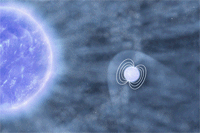
Not all of that work is going to focus on our own Sun. We’re also learning how stellar winds operate in other star systems through careful observation, as new work from the European Space Agency’s XMM-Newton space observatory reminds us. The spacecraft recently observed a flare during a scheduled 12.5-hour observation of a system known as IGR J18410-0535, where a neutron star and a blue supergiant are in close proximity. The flare, which at X-ray wavelengths was almost 10,000 times the star’s normal brightness, resulted from the neutron star trying to absorb an enormous clump of matter flung from its companion.
Image: Artist’s impression of a neutron star partially devouring a massive clump of matter. Credit: ESA.
Enrico Bozzo (University of Geneva) says the flare was the result of ‘a huge bullet of gas that the star shot out,’ one that hit the neutron star, causing the gas in the clump to be heated to millions of degrees. Although expelling matter into space is a normal part of the stellar wind for all stars, the intensity of this particular X-ray flare shows that the blue supergiant star can release chunks of gaseous matter so large that most of it didn’t even hit the neutron star.
Without the nearby neutron star, such an event would not have been detectable from Earth, but with its help we can gain insight into the varied behavior of stellar wind patterns. The XMM-Newton spacecraft recorded the flare as lasting four hours, allowing astronomers to estimate the size of the clump of matter at some 16 million kilometers across, about 100 billion times the volume of the Moon, though containing only about 1/1000th of the Moon’s mass. The neutron star, thought to be about 10 kilometers in diameter, is the collapsed core of a once far larger star, now so dense that it generates a strong gravitational field. It now proves to be a useful detector for a stellar event of the kind we should be able to observe in other such systems.
We’ve taken useful measurements of our own star’s solar wind through the Ulysses and Advanced Composition Explorer spacecraft, not to mention the continuing work of our Voyagers as they study the solar wind’s behavior at the edge of the Solar System. Even with our own relatively stable star, we’ve learned that the solar wind is turbulent, with streams of material moving at different speeds and colliding to produce so-called Co-rotating Interactive Regions. Slower moving winds tend to come from regions overlying sunspots, while high-speed winds are associated with coronal holes, dark coronal regions often found at the Sun’s poles.
A slow-moving stream pushed by faster material behind it can produce shock waves that accelerate solar wind particles to high speeds, buffeting the Earth’s magnetic field and producing storms in our planet’s magnetosphere. We also find magnetic clouds produced when solar eruptions carry material off the Sun along with embedded magnetic fields (for more on all this, see this useful MSFC page on the solar wind). Now imagine trying to ride this wind using a magnetic bubble hundreds of kilometers in diameter — formed by injecting plasma into a magnetic field — as envisioned in Robert Winglee’s Mini-Magnetospheric Plasma Propulsion idea. Or take the idea a step further still, using a magsail to decelerate an interstellar probe by braking against the destination star’s stellar wind. The more we learn about how stars shed matter, the sooner we’ll discover how practical some of these concepts really are.
Image: Artist’s impression of a mini-magnetosphere deployed around a spacecraft. Plasma or ionized gas is trapped on the magnetic field lines generated onboard, and this plasma inflates the magnetic field much like hot air inflates a balloon. Credit: Robert Winglee.
Can magsails get their push from something other than the highly changeable solar wind? Dana Andrews (Andrews Space) has argued for some time that a magnetic sail could be pushed by a neutral plasma beam. That paper makes for fascinating reading. It’s “Interstellar Propulsion Opportunities Using Near-Term Technologies,” in Acta Astronautica Vol. 55 (2004), pp. 443-451. Robert Winglee (University of Washington) developed the Mini-Magnetospheric Plasma Propulsion concept in Phase I and II studies for NIAC. The Phase II study, “Mini-Magnetospheric Plasma Propulsion, M2P2” is particularly useful (full text). It is only one of a number of magsail concepts being investigated in the literature.

A Future We Didn’t Expect
It’s always good to dream big, but sometimes dreams take you in unexpected directions. Growing up with science fiction, I reveled in tales of manned exploration of the Solar System and nearby stars, many of which I assumed would eventually become reality. But I never dreamed about personal computers. You can go through the corpus of science fiction in the first two-thirds of the 20th Century and find many a computer, but there are few tales involving personal computers on the desktop. An exception is Murray Leinster’s short story ‘A Logic Named Joe,’ which ran in the March 1946 issue of Astounding Science Fiction. Leinster invokes something like today’s massively networked computers in a story that anticipates the Internet.
How did science fiction fail to see something as huge as the PC revolution coming down the tracks? Maybe it’s because the future still surprises even those whose business it is to imagine it. I’m musing about all this because of my own desktop PC and the views it’s showing me, not to mention the continuous datastream that updates every mission I’m keeping an eye on. Surely this is a science fictional future as real as Leinster’s.
A widely distributed network lets us see things on demand, one of a kind things like an object that has never before been seen in detail as it slowly swims into focus in our cameras. We’ll have that experience in 2015 as New Horizons arrives at Pluto/Charon, but we’re also getting a taste of it right now as the Dawn spacecraft approaches Vesta. What we’re seeing in the early images has been taken for navigation purposes by Dawn’s framing camera, and as the video shows, we’re already looking at views that are twice as sharp as the best images previously available from the Hubble Space Telescope. Surface details are still a mystery, but Dawn will eventually swing as close as 200 kilometers around the asteroid.
With Vesta and then Ceres ahead of us, let’s also keep a close eye on Pluto, and we don’t have to wait until 2015. In late June, NASA’s Stratospheric Observatory for Infrared Astronomy (SOFIA) — a modified Boeing 747SP carrying a 2.5-meter telescope at high altitude — was able to observe an occultation as Pluto passed in front of a background star. This is a case where SOFIA’s airborne capabilities shone, for Pluto’s shadow fleetingly passed over a mostly empty stretch of the Pacific Ocean. SOFIA was able to position itself in the center of the shadow’s path to make the observations.
You wouldn’t think you could do much with Pluto from a mobile observatory here on Earth, but the science is actually quite rich, says Ted Dunham (Lowell Observatory), who led the team of scientists onboard SOFIA during the Pluto observations:
“Occultations give us the ability to measure pressure, density, and temperature profiles of Pluto’s atmosphere without leaving the Earth. Because we were able to maneuver SOFIA so close to the center of the occultation we observed an extended, small, but distinct brightening near the middle of the occultation. This change will allow us to probe Pluto’s atmosphere at lower altitudes than is usually possible with stellar occultations.”
I have no images of this one, but it’s easy to follow the exploits of SOFIA on the Net. It’s also worth noting that Dunham was a member of the team that originally discovered Pluto’s atmosphere by observing another stellar occultation using the Kuiper Airborne Observatory in 1988. SOFIA’s mobility allowed the scientists to quickly change position when it was learned that the center of the shadow would cross 200 kilometers north of the aircraft’s flight path. A revised flight plan and air traffic control clearance allowed the productive change of course.
Our space-based resources send us things we would never have imagined seeing, as witness ESA’s Mars Express, which was able to perform a special maneuver of its own to observe an unusual alignment of Jupiter and the Martian moon Phobos. The alignment occurred on June 1, when there was a distance of 11,389 kilometers between Mars Express and Phobos, and a further 529 million kilometers to Jupiter.
Image: Three frames from the series of 104 taken by Mars Express during the Phobos-Jupiter conjunction on 1 June 2011. Credits: ESA/DLR/FU Berlin (G. Neukum).
We often lament how the future that was imagined in the 1950s and 60s hasn’t materialized — where are the human missions to the outer planets we thought would be flying now? — but the big surprise that science fiction never showed us was what we could see by staying home. Now we wind up looking at imagery from robotic missions on demand, tapping cameras orbiting Mars and closing on major asteroids. Moreover, a high definition video stream studying Earth down to one-meter resolution from the International Space Station is scheduled to go online in 2012. No humans near Jupiter yet, but the view on our personal screens seems to be getting better all the time.

Genesis: Extraordinary Analysis of the Solar Wind
The return of the Genesis mission in 2004 was a spectacular event, its parachute failing to deploy upon re-entry, leading to a crash in the Utah desert that seemed to have destroyed the mission’s solar wind collectors. But Genesis was a tough bird and we’re getting good science from its remains. The latest news comes from study of an instrument designed to enhance the flow of solar wind onto a small target, with the aim of measuring oxygen and nitrogen. The Solar Wind Concentrator worked well and new papers out of Los Alamos National Laboratory have now appeared, with isotopic measurements of the Sun that illuminate our system’s formation.
It’s astonishing that we have these results — Genesis flight payload lead Roger Wiens (LANL) calls Genesis “…the biggest comeback mission since Apollo 13” — but ponder what we’ve got here. The spacecraft spent two years at the Sun-Earth L1 Lagrange point, some 1.5 million kilometers from Earth, collecting atoms of the solar wind, the stream of charged particles ejected from the Sun that flows outward through the Solar System. The mission’s highest goal was to determine the abundances of the stable isotopes of oxygen and nitrogen in the Sun. Oxygen contains three major isotopes: 16O, 17O, and 18O, while nitrogen’s stable isotopes are 14N and 15N.
Image: The Solar Wind Concentrator is a special instrument built by a team at Los Alamos National Laboratory to enhance the flow of solar wind onto a small target to make possible oxygen and nitrogen measurements. Shown here, the target section of the concentrator, which produced essential samples of nitrogen and oxygen. Credit: Los Alamos National Laboratory.
After years of painstaking analysis, we now have striking results. Both oxygen and nitrogen from other parts of the Solar System differ from what we find on Earth. Oxygen and nitrogen samples from various meteorites, along with nitrogen sampled in Jupiter’s atmosphere by the Galileo probe as well as that collected from samples of lunar soil, vary 38 percent for nitrogen and up to 7 percent for oxygen compared to the Earth. We now turn to finding where Earth’s oxygen and nitrogen came from. Wiens comments on the significance of the differences:
“For nitrogen, Jupiter and the Sun look the same. It tells us that the original gaseous component of the inner and outer solar system was homogeneous for nitrogen, at least. So where did Earth gets its heavier nitrogen from? Maybe it came here in the material comets are made of. Perhaps it was bonded with organic materials.”
As to oxygen, the papers point to a mechanism called photochemical self-shielding, which may have modified the composition of space dust before it even began to form the planets. The Sun shows an enrichment of pure 160 relative to the Earth instead of differences in 160, 170 and 180 that are proportional to their atomic weight. That fact points to solar UV radiation uniformly enhancing the two rarer isotopes, 170 and 180, in the terrestrial planets. We have much to learn, but Genesis’ fine-grained isotope hunt is giving us clues to how the solar system formed. All this from a mission that crashed in the desert, and analytical techniques forged from necessity that drew results from apparent disaster.
The papers are McKeegan et al., “The Oxygen Isotopic Composition of the Sun Inferred from Captured Solar Wind,” Science Vol. 332 No. 6037 (24 June 2011), pp. 1528-1532 (abstract) and Marty et al., “A 15N-Poor Isotopic Composition for the Solar System As Shown by Genesis Solar Wind Samples,” Science Vol. 332 No. 6037 (24 June 2011), pp. 1533-1536 (abstract).

